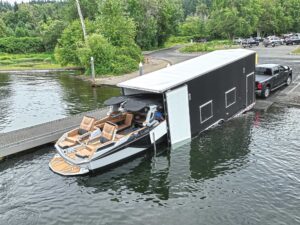Pity the pontooner. The combination of a huge footprint, a wide turning radius, sluggish response to thrust, shallow draft, the windage potential and limited sightlines from the helm can make handling a pontoon in close quarters a potentially frustrating challenge, especially when a breeze or current is present. Mercury Marine hopes to lower the stress level of pontoon captains with the introduction of Mercury Joystick Piloting for Outboards (JPO) for single-engine pontoons. The system pairs Mercury JPO technology with a pair of retractable thrusters to offer 360-degree boat control through a joystick, including the ability to guide the boat directly abeam to snug up gracefully to a dock.
A Mercury JPO single-engine system can be installed on a pontoon of any size and configuration if the boat is powered by any outboard with Mercury Digital Throttle and Shift (DTS), from 175 to 600 hp. Pontoon JPO will only be available for OEM installation on a new boat. Mercury expects Harris and perhaps a dozen other builders to offer the system this season. Harris plans to start offering the JPO system as an option in late summer, with a suggested retail price between $16,000 and $20,000.
The basic version of pontoon JPO works with a traditional hydraulic helm, requiring the captain to center the steering wheel before activating the joystick. A premium version of pontoon JPO utilizes an electric helm and is designed exclusively for use with Mercury Verado outboards and Mercury Racing Advanced MidSection (AMS) outboards. In addition to fingertip joystick control, the premium version adds an auto-heading feature and the ability to navigate to waypoints selected on a compatible chart plotter. Both features are only active under outboard power.
Mercury leveraged a number of Brunswick partners to create this system. The thruster heads are 36-volt, 105-pound-thrust MotorGuide saltwater-rated units. The props spin clockwise and counterclockwise, and Mercury created a special composite propeller for this application. Lenco designed the deployment actuators, and Blue Sea Systems designed the charging relay and battery connections. The system will be delivered to boatbuilders as a kit that also includes a Minn Kota battery charger. Mercury says three group 27 batteries have powered the system for more than an hour during demos.
Upon approaching the dock, the captain shifts the control to neutral before activating the system by pressing a button on the joystick base. The thrusters are deployed from retracted positions below the pontoon deck, one at the bow and the other at the stern, which takes about four seconds. Each thruster aligns with the prop-aimed outboard, and both are fixed—they provide lateral thrust in two directions but do not steer. The thruster props are about 10 inches below the waterline so the outboard skeg will touch bottom before the thrusters. The outboard motor provides fore and aft thrust for the boat. Manipulating the joystick simultaneously controls the outboard and both thrusters for seamless maneuvering in all directions. The thrusters automatically retract if the joystick switches off, the throttle advances, or the outboard keys off.
In the retracted position, the thrusters tuck up below the deck. The thrusters must be retracted before the boat can be loaded on a trailer. The system is compatible with bunk trailers and fork lifts, but not scissor-type pontoon trailers. We are anxious to give Mercury JPO for single-engine pontoons a test. Stay tuned.









